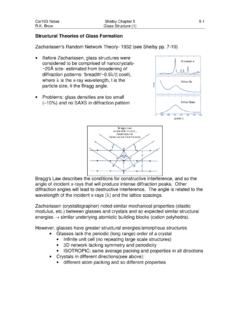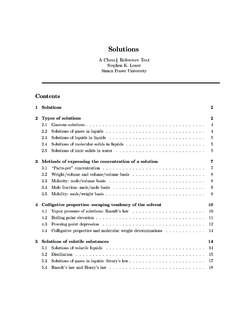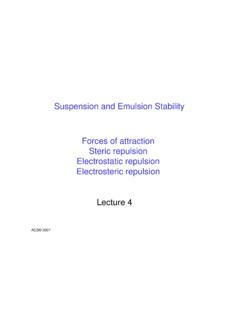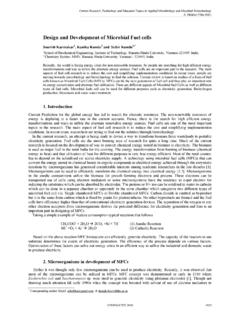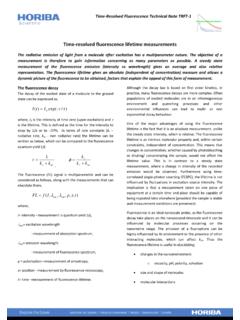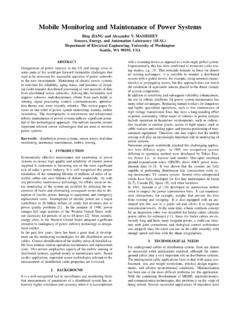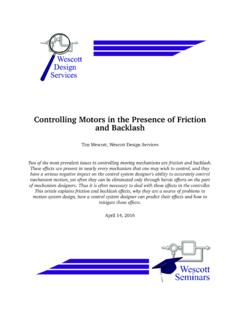Transcription of Atmospheric Pressure Ionization (API)
1 1 Atmospheric Pressure Ionization (API) conventional Ionization methods employ sources that are at high vacuum (EI, CI, FI/FD, FAB/LSIMS, MALDI) and/or temperature (EI, CI, FI/FD) the introduction of API sources employing a number of different types of Ionization has allowed very robust instruments to be developed for LC/MS These new Ionization techniques have greatly extended the range of analytes that can be studied by MS to compounds that are high molecular weight, thermally labile and polar. While the sources are designed to operate at Atmospheric Pressure we must still maintain a high vacuum in the rest of the instrument if we want to perform mass spectrometry!
2 !2 CapillaryHPLC inletNebulizerWasteheated N2 Nebulizergas inletSkimmersOctopole++++++++++++++++++L ensesVacuum WallAPI SourceVacuum PumpsMass analyzer} Atmospheric Pressure }reduced pressureHigh vacuumSpray is at right anglesto entrance toMS - orthogonalcourtesy of Agilent3 High vacuum must be maintained in the mass analyzer and detectorregion even though the source is at Atmospheric Pressure The region after the source is heavily pumped with rotary vacuum and turbomolecular pumps (usually) Also, a series of skimmers and flow restrictors are placed between the source and the mass analyzer region These skimmers allow ions to be efficiently transmitted to the high vacuum region while at the same time allow air, solvent vapours and other neutral volatile species to be pumped away The exact design will depend on the specific instrument type andmanufacturerAPI Source4 Electrospray (ESI) high flow rate (100 L/min 1mL/min) capillary flow rate (2 L/min - 100 L/min) low flow rate (<2 L/min) nanospray (200-500nL/min) ESI is most sensitive at these low flow rates Atmospheric Pressure Chemical Ionization (APCI)
3 Atmospheric Pressure PhotoIonization (APPI) Atmospheric Pressure MALDI API Sources}pneumaticallyassisted ESI5 Relative Applicability of API TechniquesESI:Electrospray Ionization & APMALDIAPCI: Atmospheric Pressure Chemical IonizationAPPI: Atmospheric Pressure Photo IonizationEI, CI, GC-MSMolecular WeightAnalyte PolarityESI & APMALDI1000100,00010,000nonpolarvery polarAPCI & APPI6 Electrospray (ESI) Based upon the electrostatic spraying of liquids where a solution is passed through a needle held at high voltage (kV) relative to a counter electrode (the entrance to the MS) When the solution contains an electrolyte and the needle forms part of the API source then the fine mist of droplets that emerge from the needle tip possesses a net +ve or ve charge determined by the polarity of the needle and the solution chemistry of the bulk liquid These preformed and then sprayed ions, which are characteristic of the dissolved analytes, are attracted to the entrance of the MS by applying appropriate voltages7 Electrospray (ESI) The formation of the spray must be aided by nebulization (pneumatically assisted)
4 At liquid flow rates higher than a few L/min ions exist in solution, if not, electrospray doesn t work, it is not an ion formation technique rather than a technique for extracting ions from the solution-phase into the gas-phase free of solvent for mass spectral analysis The analyte must be an ion in solution either as a preformed ion such as or through modifying the solution chemistry to induce a charge This can be accomplished by changing solution pH or adding cations egLi+, NH4+etc or anions to form adducts eg Cl-, OAc-etcN8 Electrospray Ionization ++++++++++-----CoulombicExplos ions++++++--++++++--RayleighLimitReached ++++++++++-----Evaporation++Analyte Ion(proton transfer andadduct ions)Solvent Ion ClusterCharged Dropletscontaining ions in solutionAnalyte Ions in the gas phase- both +ve and -veNebulizer assisted >1 L/min- capillary 2-100 L/min- normal Classical - nanospray < 1 L/min9 The Source Taylor cone++++++++++++++++++++++++++++++++++++ +++High voltagePower supply-electronsAnode -oxidation++++++-+++++++++------++++++++ ++++++++++++++++++++++++cathode - reductionto MS10 Proposed Residue Model:where the droplet is completely evaporated leaving bare analyte Evaporation Model.
5 Field assisted ion desorption Requires ~ 107 Vcm-1and a final droplet diameter of 10nm Fits well with the observed data In either case it is required that the analyte be an ion in solution (+veor ve) or made to be charged by modifying the solution to cause the analyte to be ionized This can be accomplished by changing pH, adding modifiers (Na+, Li+)11 Electrospray Solution Chemistry Mobile phase pH has a major effect for analytes that are ions in solution: Basic pH for negative ions Acidic pH for positive ions Changing pH can enhance performance for analytes that are not normally ionized in solutionPositive Ion ModeR1 R1| |:N - R2+ HA +HN - R2+ A-| |R3 R3 Base Acid Analyte IonO O|| ||R-C-OH + :B R-C-O-+ H.
6 B+Acid Base Analyte IonPositive ion mode, [M+H]+Negative ion mode, [M-H]-12 In the case of acid/base chemistry, ideally we want to be 2 pH units either side of pK in order to cause complete protonation (+ESI) or deprotonation (-ESI) to give maximum sensitivity In the case of batch introduction (infusion) of sample this is easily accomplished however in the case when LC is employed it is the nature of the mobile phase that determines the ions we will observe and the sensitivity For example, in a reversed phase (C18) separation of analytes, in order to achieve a good separation it is necessary for the analytes to be neutral in solution so that they may interact with the stationary phase and achieve a good separation.
7 These neutral species will not yield the best sensitivity when ESI is Solution Chemistry13 Don t forget, the ESI process is a competition for charge! A neutral in solution will pick up charge in a variety of ways and while we can influence which process is favoured we can not eliminate all competing ion formation mechanisms Not only do proton transfer reactions occur but adduct ion formation is commonly observed Species such as [M+NH4]+, [M+Na]+and [M+K]+in positive ion and [M+OAc]-and [M+Cl]-in negative ion are often observed even though these modifiers may not have been deliberately added to the solution containing the analyteElectrospray Solution Chemistry14+ESI of Nucleotide Homologue (mw=890)Sample in 1:1 CH3CN/H2O+ formic acid[M+H]+[M+NH4]+[M+K]+[M+Na]+15 Electrospray ConsiderationsSamples.
8 Ions in solution: catecholamines, sulfate conjugates, quaternary amines, carboxylates, phosphorylated compounds Compounds that can have a charge induced: carbohydrates Compounds containing heteroatoms: carbamates, benzodiazepines Multiply charged in solution: proteins, peptides, oligonucleotides A curious feature of ESI is the formation of multiply charged ions iewhere z>>1 and sometimes as high as 10016 Electrospray ConsiderationsSolution Chemistry Parameters: flow rate sample pK, solution pH solution conductivitySamples to Avoid: extremely non-polar samples: PAHs, PCBs Samples containing high levels of buffers/electrolytes as this will cause ion suppressionIon Suppression: Competition and interference with analyte Ionization by other endogenous matrix species resulting in decreased number of ions characteristic of the analyte(s)17 Protein ESI-MS In this mass spectrum, each peak represents the quasi molecular ion of the protein with one more charge attached, usually, but not always, a proton (H+) eg m/z is the [M+18H]18+ Consequently, each peak can be used to calculate the mwt of the protein and the resulting values averaged across all charge states.
9 This results in mass accuracies for protein mwt determination of + or better depending on the type of mass spectrometer Let the unknown mass of the protein be Mand the # on charges be ncorresponding to the addition of (M+nH)+ For 2 adjacent measured masses m1 (high mass) and m2(low mass) we can write 2 equations:m1= (M+n)(i) and m2= (M+n+1)(ii)n(n+1)Solving for n:for the ion at m/z (m1) = (M+n)998n = M+nnfor the ion at m/z (m2) = (M+n+1) + = M+n(n+1)Consequently:998n = + n =17 for m1(m/z 998)Substituting n=17 in (i) gives M = (m1n)-n = (998x17)-17 = 16,949 These laborious calculations can be performed for all ion in the distribution or a software deconvolution can be performedProtein ESI-MS19+ESI of a ~39kDa Protein - Infusion@1 L/minm/ z115011601170118011901200121012201230124 01250%0100[M+33H]33+[M+32H]32+[M+18H]18+ [M+22H]22+[M+50H]50+m/z200400600800 1000 1200 1400 1600 1800 2000 2200 2400 2600 2800%010020 Software DeconvolutionSoftware manipulation of the full scan +ESI data to show protein mwtmass393003940039500396003970039800399 004000040100%010039,643+ the charge states of the gaseous ions generally represent the charge states in the condensed phase.
10 These are sometimes modified by ion/molecule collisions. Ions such as large biomolecules are highly charged. the transfer of ions to the gas phase is not an energetic process. Ions are cold, in fact the desolvation process further cools ions. non-covalent interactions can be preserved when the species enters the gas phase. This is significant for the application of ESI to the study of biological molecules such as mass spectra of bovinecytochrome c22 Raffinose trisaccharide, mwt=504 +ESIm/z100125150175200225250275300325350 375400425450475500525550575600%0100m/z10 0125150175200225250275300325350375400425 450475500525550575600%0100m/z10012515017 5200225250275300325350375400425450475500 525550575600%0100in 1:1 MeCN/H2O+5mMNH4 OAcm/z 522 (M+NH4)+In 1:1 MeCN/H2O+ 505 (M+H)+m/z 522 (M+NH4)++LiOAcm/z 511 (M+Li)+2

